
About UsThe Numismatic Bibliomania Society is a non-profit organization promoting numismatic literature. For more information please see our web site at coinbooks.org SubscriptionsThose wishing to become new E-Sylum subscribers (or wishing to Unsubscribe) can go to the following web page link MembershipThere is a membership application available on the web site Membership Application To join, print the application and return it with your check to the address printed on the application. Membership is only $15 to addresses in the U.S., $20 for First Class mail, and $25 elsewhere. For those without web access, write to: David M. Sundman, Secretary/TreasurerNumismatic Bibliomania
Society AsylumFor Asylum mailing address changes and other membership questions, contact David at this email address: dsundman@LittletonCoin.com SubmissionsTo submit items for publication in The E-Sylum, just Reply to this message, or write to the Editor at this address: whomren@coinlibrary.com
BUY THE BOOK BEFORE THE COINYou won't regret it! |
- WAYNE'S WORDS: THE E-SYLUM MARCH 20, 2011
- NBS NEWS AND NOTES: MARCH 20, 2011
- NEW BOOK: MONEY OF ANCIENT JUDEA AND ISRAEL
- NEW BOOK ON CHINESE FAKES OF NORWEGIAN COINS
- BOOK REVIEW: MONEY OF THE AMERICAN COLONIES AND CONFEDERATIONS
- BOOK REVIEW: THE SILVER COINS OF MASSACHUSETTS BY SALMON
- ARNOLD SPAER 1919-2011
- DAVID MENCHELL ON F. GORDON FROST
- MORE ON SARAH SOPHIA BANKS
- STILL MORE ON DAMASCENED MEDALS
- NEWSLETTER: CHOPMARK NEWS RELAUCHED
- MORE ON WIRE, KNIFE AND ROLLED RIMS
- HARVEY STACK ON WHO WORKED AT STACK'S IN 1966
- QUERY: WHERE AND WHEN WAS STUART M. MOSHER BORN?
- QUERY: THE FIRST STREET COIN DEALER IN NEW YORK?
- CAN UNPUBLISHED MANUSCRIPTS BE SAVED?
- NOTES FROM E-SYLUM READERS: MARCH 20, 2011
- CHRISTOPHER MEMMINGER AND THE CREATION OF CONFEDERATE CURRENCY
- PUBLISHER LIMITS SHELF LIFE FOR LIBRARY E-BOOKS
- LIBERTY DOLLAR CREATOR CONVICTED IN FEDERAL COURT
- DICK JOHNSON ON GOVERNMENT SCAM ALERTS
- WASHINGTON POST ARTICLE ON NATIONS OUTSOURCING BANKNOTE PRODUCTION
- BANK OF CANADA SWITCHING TO POLYMER NOTES
- EARTHQUAKE DAMAGE TO LIBRARIES
- FEATURED WEB SITE: THE CHOPMARK COLLECTORS CLUB
WAYNE'S WORDS: THE E-SYLUM MARCH 20, 2011

Among our new subscribers this week are Joel Turner and Robert Feiler. Welcome aboard! We now have 1,406 email subscribers, plus 123 followers on Facebook, including Dan Aidif.
This week we open with some NBS business, followed by announcements of two unusual numismatic books. Next up are reviews of two books on U.S. colonial coins, an obituary of Seleucid coin expert Arnold Spaer, and more great information on Sarah Sophia Banks, builder of a magnificent collection of early U.S. coins and medals.
Other topics include chopmarks, Stuart Mosher, unpublished numismatic manuscripts, Confederate currency, and e-books. To learn more about Chinese counterfeits of Norwegian coins, the first "street coin-vender" in New York, and damage to libraries in last week's earthquake in Japan, read on. Have a great week, everyone!
Wayne Homren
Numismatic Bibliomania Society
NBS NEWS AND NOTES: MARCH 20, 2011
 NBS Secretary-Treasurer David Sundman reports that the latest edition (Volume 28, Nos. 3&4) of the Asylum has been shipped to our membership from the printer.
NBS Secretary-Treasurer David Sundman reports that the latest edition (Volume 28, Nos. 3&4) of the Asylum has been shipped to our membership from the printer.
Inadvertently, the annual renewal envelopes were included in everyone's copy, instead of only those who were up for renewal. The address label should show your year of membership, and those with a 10P are the ones that should reply. If you have any questions about your membership status, please email us at the following email address: NBS.Sec.Treas@gmail.com, or contact Wendy Joseffy by phone at 603-444-3545. Thank you!
Alan Luedeking writes:
"Regarding my article on Humberto Burzio just published in The Asylum, Vol. 28 Nos. 3-4, July-Dec. 2010, it should be noted that the image credit inadvertently dropped out of the final version as published. The image of Mr. Burzio is courtesy of Centro Numismático Buenos Aires."
NEW BOOK: MONEY OF ANCIENT JUDEA AND ISRAEL
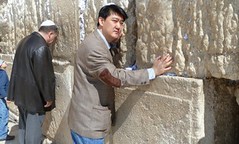 Xu Long, head chef at Beijing's Great Hall of the People, has literally written the book on Israeli coins.
Xu Long, head chef at Beijing's Great Hall of the People, has literally written the book on Israeli coins.
One of the most passionate collectors of Israeli coins is the head chef in Beijing's Great Hall of the People. When Xu Long isn't cooking Peking duck for visiting heads of state, he devotes his time to researching the history of Jewish coins.
It took him 10 years of painstaking study, but last November Xu Long published a 575-page hard-back on the subject, Money of Ancient Judea and Israel.
Ironically, his book, which is in Mandarin, is one of the most wide-ranging on the subject in any language.
"His book starts with the first coins ever minted in Judea during the Persian period in the fourth century BCE and goes up to the Jerusalem of Gold 24-carat bullion coin launched last year by the Bank of Israel," says Arthur Boxer, CEO of the Israel Coins and Medals Corporation (ICMC). "He explains the story behind each coin."
Boxer meets Xu Long every year at the International World Money Fair in Beijing, where display of the book helps attracts local collectors to the Israeli booth. At a price of 498 yuan, about NIS 250, the book is expensive in China.
"He's an ambassador for us in China," says Boxer. "It's a numismatic handshake between two great ancient cultures."
Last week Boxer and Xu Long met at the ICMC headquarters in Nesher, near Haifa. Visiting for his second time, Xu Long continues to explore sites not on the typical tourist itinerary but that figure on Israeli currency and coins. Last time he came alone; this time he brought six other coin enthusiasts.
"The first time I came to Israel everything seemed familiar to me because I already knew about places from the coins," says Xu Long, 47.
Xu Long was riding his bicycle on one of Beijing's streets when he spotted a foreigner and stopped to ask the man if he spoke French. The foreigner was Albert Kalifa, an Israeli studying Chinese medicine in Beijing, Algerian by birth and fluent in French.
"He asked me if I would like to teach him French and I said, ‘Why not,' Kalifa says in a telephone interview from his home in Kibbutz Nir Eliahu. "We met every day for French lessons for about half a year and he taught me about Chinese customs and way of life."
Kalifa knew of Xu Long's interest in coins and gave him a few Israeli coins.
"This aroused a great curiosity in him about Jewish customs and life and he asked many questions. He was insatiable for information about Israel and Judaism," says Kalifa. "During his first visit to Israel, he wanted to see every spot that appears on Israeli paper money and coins. We went to off-the-beaten-track places like Gymnasia Herzliya, Mikve Yisrael, Beit Bialik, anything connected with coins. He must have taken about 10,000 photos.
"When he travels in the world he also seeks Jewish sites. In Tehran he got a special permit to visit a synagogue.
In Rome he went to the Arch of Titus. In Paris he went to a Jewish museum. On this trip he wanted to see a pidyon haben ceremony, Kiddush and a circumcision ceremony, all events that appear on coins. It's unbelievable what he accomplished. A person who doesn't know anything about the history of the Jewish people can learn about it just from reading his book."
To read the complete article, see: Chinese chef's main course: Ancient Jewish coins (www.jpost.com/Features/InThespotlight/Article.aspx?id=212141)
NEW BOOK ON CHINESE FAKES OF NORWEGIAN COINS
Just yesterday morning someone posted some information on the Zeno website (an oriental coin database) about a catalog of Chinese fakes of -- Norwegian coins! E-Sylum readers are familiar with the fake US coins being made in China, and collectors of Chinese coins are aware of how many fake Chinese coins are being made there.
A new book has been published cataloging known Chinese fakes of Norwegian coins: Kinesiske Kroner og Dalere [Chinese Crown and Thaler (Fakes)] by Kjetil Kvist, published in Oslo, Norway in 2009. The 61 page spiral bound book lists more than 60 different Norwegian coins which are being counterfeited in China.
Apparently the author visited one or more of the fake factories or talked to someone who had, and reports the following details:
1) There are around 100 fake coin factories in China today.
2) Each one is capable of producing 100,000 coins per month.
3) It takes about a week to make a new die.
4) The best known counterfeiting operation, Big Tree Coin Factory in Fujian province (opposite Taiwan) employs 30 people.
5) The cost to produce fake coins runs from US 8 cents to 50 cents.
6) The coin factories have a network of distributors around the world. They use eBay for advertising purposes (that is, to attract more distributors).
This information is from the Zeno website (www.zeno.ru) -- a database of images and information on oriental numismatics (that is, everything from the Mediterranean to the Pacific), ancient and modern. There are over 1,500 members around the world and the site presently contains images of over 97,000 items.
Members may upload images of their coins or the coins of others (with permission from the owner), and may make comments on items listed. Membership is free but it is not necessary to be a member to view the site. The site is particularly rich in Islamic, Indian and Chinese coins.
To visit the zeno.ru web site, see: www.zeno.ru
BOOK REVIEW: MONEY OF THE AMERICAN COLONIES AND CONFEDERATIONS
Lou Jordan writes:
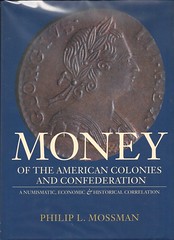 Phil Mossman's Money of the American Colonies and Confederations: A Numismatic, Economic and Historical Correlation (ANS 1993) is the most important book of the twentieth century on colonial American numismatics. Borrowing some lines from an introduction I am contributing to a forthcoming book, I describe the work as follows:
Phil Mossman's Money of the American Colonies and Confederations: A Numismatic, Economic and Historical Correlation (ANS 1993) is the most important book of the twentieth century on colonial American numismatics. Borrowing some lines from an introduction I am contributing to a forthcoming book, I describe the work as follows:
Phil's book explained colonial coinage in terms of economic history. From the macroeconomic perspective he discussed which coins were in circulation and how they were used, thus placing the confusing assemblage of colonial coinage in an historical context. From a microeconomic perspective he explained the importance of coin weight as a fundamental factor in the profitability and success of a mint and from this perspective was able to classify coin varieties by weight distribution thus providing new insights on minting techniques and possible counterfeits. The book is extremely well written, covering two hundred years of numismatics in America in a clear and thoughtful manner.
To read the earlier E-Sylum article, see: QUERY: REVIEWS OF MOSSMAN BOOK SOUGHT (www.coinbooks.org/esylum_v14n11a13.html)
BOOK REVIEW: THE SILVER COINS OF MASSACHUSETTS BY SALMON
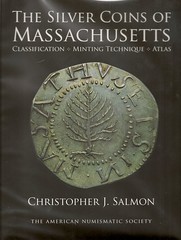 Review of Chris Salmon's The Silver Coins of Massachusetts, American Numismatic Society 2011
Review of Chris Salmon's The Silver Coins of Massachusetts, American Numismatic Society 2011
I've collected and specialized in Massachusetts Colonial Silver Coinage since high school (I'm now 67) . Ironically, my 20 year LAPD career (retired in 1991) commenced with the imposition of my serial # 16652 - how's that for pure coincidence?
So when I first read in The E-Sylum some months ago that a Christopher Salmon was near completion of an ANS book on Mass silver, I didn't put too much stock in it. After all, I'd never heard of Chris Salmon in numismatic circles and the Sidney Noe ANS monographs, the ANS 1991 Exhibition of Mass silver monograph, and Mike Hodder's Stacks Ford sale catalogue XII were all the references one needs for this series.
So when Tony Terranova called me two weeks ago to ask if I ordered the new book, I said no. I was no longer an ANS member, having dropped my multi-decade membership, as did others, when ANS sued for treble damages against third party innocent buyers of ANS-Sheldon-Naftzger large cents.
Tony's been a longtime good friend, numismatic counselor and source of some great coins in my collection so he said he'd mail me a copy gratis. Okay, thanks. When it arrived Priority Mail a few days later, my reaction was "Wow!". I've since learned from others that they'd also just received their books.
The sheer magnificence of this book takes the breath away. It is a coffee-table size book, approximately 12" x 10" and 293 pages thick. The plates are magnificent. Printed in China (where Whitman Publishing prints their books so they can be sold quite affordably) and really high quality.
Author/researcher Christopher Salmon, an M.D. radiologist, apparently had a great deal of cooperation from the ANS photographic files and the ANS cabinet along with Stack's voluminous photographic files of Mass silver. There was no attempt to picture in the greatly enlarged photographic plates the finest knowns, but almost all varieties are illustrated with decent quality specimens. There is an attempt to re-number the Noe / Crosby varieties into Salmon-numbered varieties and time will tell if this "takes" - but I don't think so.
There are some perceived weaknesses in the book, as there are with any book:
An awkward title: The Silver Coins of Massachusetts - why not simply Massachusetts Silver Coinage? Longtime collectors do not refer to Massachusetts colonial silver as "coins" (like so many slabbed items) but rather the more sophisticated and respectable term: "coinage".
The overuse of tongue-twister, highly technical terms sometimes sends the reader fleeing to a thesaurus or just shaking his head in confusion. But this is all too common with museum and institutional publications that seem to think that the more highly technical the text is, the more acceptable the research.
While the plates in general are superb, two of the most important images - that of the unique New England threepence in the Massachusetts Historical Society and the ex. rare NE sixpence on page 4 are third generation dot- matrix images when 1st class original photographic images are easily obtainable of these exact specimens - particularly important with the NE 3d of which a few highly deceptive modern forgeries have very recently surfaced, including one which was sent over from England for sale.
There are other weaknesses such as a failure to photograph and address the distinctive angle-sheared and filed silver edges which are diagnostic for any higher grade genuine silver shilling (the forgers often forget the distinctive diagnostic character of genuine coins' rims) when the less-important varied thinness and waviness of planchets is photographically addressed.
But overall, the book is extremely pleasant to read or just leaf through for its photographic beauty. It is crucial for any American colonial collector or early copper specialist, any enthusiast of silver hammered coinage, or even ancient coinage since Massachusetts silver is widely regarded as American "ancients" - the same aesthetics apply.
You don't have to be a library to purchase from their catalog - anyone can do it. Several years ago I bought a package of assorted size jacket covers, and they've come in handy over the years. The above image was shot thru the jacket cover because I wasn't smart enough to scan the book first, and didn't want to take the time to remove and replace it. -Editor
THE BOOK BAZARRE
ARNOLD SPAER 1919-2011
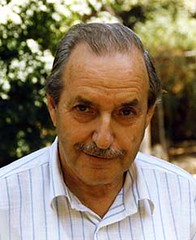 Arnold Spaer a renowned collector of ancient coins passed away in Jerusalem on Friday March 4, 2011. Haim Gitler has send us his biography, which was written by Dan Barag and Boaz Zissu and appeared first in INJ 17, which was dedicated in honor of Arnold Spaer.
Arnold Spaer a renowned collector of ancient coins passed away in Jerusalem on Friday March 4, 2011. Haim Gitler has send us his biography, which was written by Dan Barag and Boaz Zissu and appeared first in INJ 17, which was dedicated in honor of Arnold Spaer.
Arnold was born to Mark and Ada Spaer in the Free State of Danzig on March 28, 1919. In 1933 the local Nazi party achieved dominance in the city government and demanded the return of Danzig to Germany. This development convinced many Jewish families to leave the city. The Spaer family arrived in Tel Aviv in 1934, and young Arnold enrolled in the Ben-Yehuda Gymnasium.
Arnold developed a zeal for collecting from an early age, starting with postage stamps – an excellent tool for the study of geography. His first acquisition of ancient coins, at the age of eight, consisted of three late bronze issues of Constantine, apparently discovered in a hoard in the Danzig area. While he was a student in Jerusalem, he continued to buy coins and eventually became particularly interested in Seleucid and Crusader coinage.
Arnold purchased his coins on the local market, mainly in Jerusalem, but at times in Turkey, Central Europe and elsewhere. He indexed them all meticulously on cards, with information on their source of acquisition and provenance, when available. His collection includes more than ten thousand ancient coins.
Arnold Spaer's most important contribution to numismatics is the publication of his collection of Seleucid coins. A long, friendly association with Arthur Houghton, a leading authority in this scholarly field, led to the publication of The Arnold Spaer Collection of Seleucid Coins (London, 1998). This fascinating 389-page volume, displaying 2919 coins on 189 plates of excellent photographs by Zeev Radovan, is a work of lasting value for scholars as well as collectors. The book presents Seleucid coinage in general, with great detail about minting and circulation in ancient Palestine, southern Phoenicia and Syria. It is thus a useful research tool in the field of Seleucid coinage.
To read the complete article, see: An Obituary to Arnold Spaer (www.coinsweekly.com/en/Article-of-the-week/5)
DAVID MENCHELL ON F. GORDON FROST
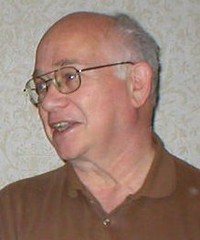 "I knew Gordon through memberships in several local clubs, and usually ran into him at local shows such as the New York International. Gordon loved books and the knowledge that they contained. He had thousands of them stockpiled in his living room, basement and garage, and what's even scarier, he appeared to have read them all and could provide you with information from them.
"I knew Gordon through memberships in several local clubs, and usually ran into him at local shows such as the New York International. Gordon loved books and the knowledge that they contained. He had thousands of them stockpiled in his living room, basement and garage, and what's even scarier, he appeared to have read them all and could provide you with information from them.
Those of us fortunate to become members of Gordon's inner circle eventually would rate a "box". I would get a call in my office in the evening that would typically go "Hello, this is Gordon Frost. I know you're busy but I found a couple of books I thought you might be interested in. There's no obligation. I'll just put them aside in your box and when I see you, you can look at them and decide if you're interested."
Invariably, I would purchase whatever Gordon had set aside. He had a knack for sizing up people bibliographically, and was able to find an unusual item of interest to you. It wasn't always numismatic; he knew I enjoyed Pre-Columbian and Native American art and Colonial history and provided me with a number of books and catalogues in these areas.
I'll miss Gordon, his enthusiastic discussion of a new acquisition, his wry humor, and his love of chocolate, supplying the members of the Bronx Coin Club with their chocolate fix each month stating that we could use some added "nutrition".
If Heaven has a library, I'm sure Gordon's there now, researching some facet of treasure ships, or making sure to set aside some books for the residents in their "boxes"."
To read the earlier E-Sylum article, see: MORE ON F. GORDON FROST (www.coinbooks.org/esylum_v14n11a11.html)
MORE ON SARAH SOPHIA BANKS
Alan V. Weinberg writes:
 Amazing how casual comments can lead to even more fascinating information on e-Sylum.
Amazing how casual comments can lead to even more fascinating information on e-Sylum.
One of the major items I distinctly recall in 1966 in the British Museum trays (and which I had photographed at the time), was a superb prooflike, largely mint red ornamented edge George Washington "Peter Getz" pattern copper cent, previously known as a "half dollar". It is the finest "Getz" copper (or silver, surpassing the # 1 Ford silver with its cabinet friction) extant and is plated/catalogued as #1 in George Fuld's 2009 splendid book on Washington pattern coinage by Getz. Its pedigree goes back to Sarah Sophia Banks in 1818.
As to John Dannreuther's comments regarding tags showing SSB, all the tags I saw - many dozens - said Sophia Banks (I would not have known who "SSB" was) or Sir Joseph Banks and most were dated 1800- specifically the tag for the 1792 half disme which had been missing. I distinctly recall assuming that the missing half disme must've been Gem Mint State having been donated so near to 1792 and I'm certain that tag said Sir Jos. Banks. I'm also certain many other tags said Sir Jos. Banks 1800 as I would not have known who Sophia Banks was at that time and presumed she was Sir Joseph Bank's wife since their gifts to the BM were so similar in numismatic nature and date.
From the extreme rarity (even in that era- i.e. two Higleys in nice condition) and top condition of the American coins, it is difficult to presume a friend merely acquired and forwarded the coins to the Banks family unless that friend was himself an accomplished numismatist with excellent contacts. I continue to believe that at least one of the Banks arrived to visit America and gathered the specimens himself/herself. They were too accomplished a family not to have visited the U.S.
As The E-Sylum described the tall imposing brash and loud Sarah Sophia Banks, I kept mentally viewing her image - the distinguished 1930's British and American film character actress Edna May Oliver!
Philip Mernick writes:
I emailed Catherine Eagleton at the British Museum on the "How did Sarah Sophia Banks get her early U.S. coins?" question. She is their specialist on the Banks collection
Katie Eagleton writes:
I saw The E-Sylum mentions of Sarah Sophia Banks. I know quite a bit about where she got all her early U.S. coins from, and can name most of the individuals involved, in fact. It's going to be a section of the book I'm writing at the moment, for which 200 pages are already drafted, and I'm just looking for a suitable publisher. Probably the whole thing won't be finished until 2012-3 now, because of some other projects I'm working on, but it's well under way.
Pete Smith writes:
In 1990 I began to gather short biographical sketches for people who were important in the collection of U. S. large cents. This was published in six issues of Penny-Wise and gathered into a monograph published in 1992.
Some time later I thought of doing the same thing for the field of Conder tokens. I was missing some important sources, the project stalled, and the listing remained unpublished. Following is the sketch I prepared for Sarah Sophia Banks (1744-1818):
"Miss Banks was the sister of Sir Joseph Banks (1743-1820), the botanist. She collected books, objects of natural history and coins. She is listed as a contributor to Birchall's book. The Gentlemen's Magazine for March 1818 describes, "the cabinet of a lady of distinguished rank and acquirements, whose condescending urbanity renders of easy access her very splendid collection, which, more especially for modern coins, Patterns, and Medals, has, I believe, no rival…" Her collection and notebooks went to the British Museum. She died on September 27, 1818, in Soho-square at the home of her brother. (Bio in Dictionary of National Biography.)"
To read the earlier E-Sylum article, see: SARAH SOPHIA BANKS (1744-1818) (www.coinbooks.org/esylum_v14n11a07.html)
STILL MORE ON DAMASCENED MEDALS
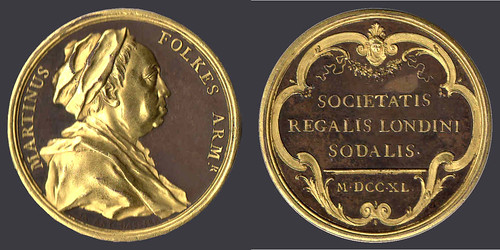
In a follow-up to Philip Mernick and Christopher Eimer's responses on damascened medals, Dick Johnson asked me to forward them this note:
Can either of you describe how the damascene gold was applied if these medals were made in the 18th century?
As a coin and medal technologist I like to learn HOW such items were made.
I surmised -- possible incorrectly -- that these were restrikes and made by electroplating the gold on a medal that was first bronzed (for the dark patina), then masked off before goldplating. That is the most logical method I could imagine. That is how they could be made today.
However, if you can document these were, indeed, made with the damascene gold in the 18th century when these medals were first issued, can you tell me HOW this was accomplished?
If the gold leaf was applied as Chris suggests, how was it applied to only the relief surfaces?
It the gold leaf was applied to the entire surface, it would then require chasing to remove it from the background or field. This would be a very tedious chore and very time-consuming for an issue of any quantity of medals.
Could the gold leaf be applied to the die before striking and then removed from the field (which would be the high surface on the die), then struck for the gold to adhere to the medal's surface?
Have either of you seen any of this gold surface flaked off, or removed (to bleed and show the surface under the gold)?
I am trying to acquire the specimen from my local coin dealer that prompted this discussion Then I will scratch off some of that gold to reveal the under surface. That should provide a clue.
While there is no doubt in my mind that the damascened medals of Dassier are authentic eighteenth-century productions, my knowledge of the procedure is somewhat sketchy. My basic understanding is that the entire surface of the medal is gold-leafed, and the gold leaf in the areas that do not constitute the relief is then removed.
William Eisler has written extensively on the Dassier family and their medals and would I think be far more qualified to provide an explanation of the procedure.
Philip Mernick writes:
By coincidence Tuesday's lecture at the Royal Numismatic Society here in London was by William Eisner on the subject Jean Dassier and his Rois d'Angleterre (medals). Mr Eisner, originally from New York but resident in Lausanne, Switzerland for many years, explained the role that religion and politics played in Dassier's promotion of this series of medals.
He made it clear that damascened bronze was one of the options offered from the start, in the 1720s, the others being bronze, silver and gold, although the latter were never produced. I took the opportunity of asking Mr Eisner about the damascening process. He said that he did not know how they were made although examination of damaged specimens indicates that the gold was applied over the bronzed finish.
He also told us that Dassier was not the first to offer damascened medals - the process having been used in the 1670s for a French series of medals. This could, I suppose, have been Mauger's Histoire Metallique series. He said the 1740 Martin Folkes medal was the first of a new series issued by Jean Dassier's son Jacques-Antoine Dassier (1715-59).
Dick Johnson writes:
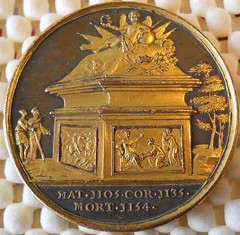 This week I have acquired from my local coin dealer the Dassier medal from the Kings of England series that prompted this string of comments. Please express my genuine thanks to Philip Mernick for bringing this matter to the attention of William Eisner at this week's meeting of the Royal Numismatic Society in London.
This week I have acquired from my local coin dealer the Dassier medal from the Kings of England series that prompted this string of comments. Please express my genuine thanks to Philip Mernick for bringing this matter to the attention of William Eisner at this week's meeting of the Royal Numismatic Society in London.
I am further appreciative of his mentioning that the bronzing of each of these damascene medals is UNDER the gold. I was going to scrape off some of the gold on my new acquisition to determine if the bronze was indeed under the gold -- and therefore applied before the gold leaf was applied. Now I don't have to and my medal can now remain intact.
I accept all three gentlemen's assertion that the gold was applied as gold leaf, and the portion that reveals the bronzed patina underneath was somehow removed (although no one knows, it seems, how this was accomplished). Also I accept that the medals are not restrikes (after which they could have been goldplated). So my early theory has now been disproven.
Thank you to each numismatist who favored E-Sylum readers with your wisdom: Christopher Eimer, Philip Mernick, and William Eisner. You are to be commended.
To read the earlier E-Sylum article, see: MORE ON DAMASCENED MEDALS (www.coinbooks.org/esylum_v14n11a10.html)
NEWSLETTER: CHOPMARK NEWS RELAUCHED
Colin Gullberg writes:
The Chopmark Collectors Club has just relaunched their newsletter, Chopmark News. The newsletter will be published quarterly and contains information regarding chopmarks - the countermarks applied by Chinese merchants during the China trade period which ran roughly 1600 - 1935. The journal will investigate and document the different chops and their meaning. Recent sales will be discussed and persons important to the chopmark coin world will be interviewed. Please contact Colin Gullberg, the current editor, for a free e-copy at: chopmarknews@gmail.com .
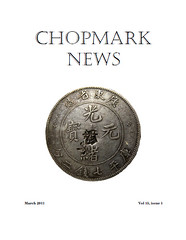 Greetings from your new editor in Taiwan.
Greetings from your new editor in Taiwan.
For the longest time I resisted approaching Rich Licato offering to take over the job of edi-tor of the CCC newslet-ter. It seemed like such a daunting job putting out a newsletter cover-ing a field of numismat-ics that little is known and agreeing to do it on a regular, hopefully quarterly, basis. Yet this is what I have decided to do.
You may well ask why?
Perhaps the answer is why mountain climbers attempt Everest: Be-cause it's there.
Seriously, I feel that I can offer something of interest to the club members and put out a quarterly publication.
Everett Jones started the newsletter in July 1990—BEFORE the internet existed— and managed to more than I probably ever will even with the resources avail-able on-line now. Mark Benvenuto and Rich Licato also did excellent jobs as editors. I can only hope I do half as good a job as my predecessors did.
Each edition will include an interview with some-one of interest. In addition, I am including columns where we can introduce ourselves [Meet our Members] as well as eBay sales. Most importantly, I am going to devote 2-3 pages of each issue exploring and as-signing individual numbers to each chopmark. This has never been done in any systematic way before but is the most important thing I think the newsletter will try to accomplish. It is a huge job as there are possibly thousands of different chopmarks.
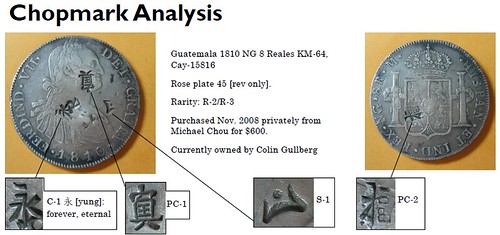
Good luck to Colin and the organization - we'll look forward to more issues of this excellent publication. -Editor
THE BOOK BAZARRE
MORE ON WIRE, KNIFE AND ROLLED RIMS
David Lange writes:
There was discussion of some of the odd nomenclature misused to describe border and rim varieties. Early in my career with NGC I took on the task of updating and generally improving our quarterly Census Report (which is now a weekly, online report). There was some inconsistency in how coins were being labeled and several instances of the same coins being labeled differently at various times.
Once this was sorted out, I addressed a couple of my pet peeves, one of which was the term "rolled edge." I believed this to be nonsensical, since there was no actual rolling of the edge, and I changed it to something more numismatically accurate. I also changed "wire edge" to read "wire rim," since there was clearly no fin or flash on the coins' edges.
Finally, I eliminated unnecessary or redundant descriptors, such as the word "rays" on 1866 nickels and the word "arrows" on 1874 dimes, quarters and halves. Since all of the coins of these dates included such features, it seemed unnecessary to distinguish them the way one would for the transitional dates of 1867 and 1873, respectively.
A couple of months went by before we began to receive complaints from prominent coin dealers that their customers were reluctant to buy coins not labeled exactly as in the Red Book. I argued my points detailed above, but ultimately I had to change all the labels back to their familiar forms, regardless of any numismatic conflict. It was an early lesson that in the commercial sector marketing ultimately wins out over numismatics, but then I tend to be a bit pedantic in this area.
I've had numerous email exchanges with Ken Bressett about terminology and coin descriptions in the Red Book. While he listens sympathetically, it often turns out the traditional nomenclature, whether or not numismatically correct, rules the day. It's very hard to change minds when it comes to familiar customs in American numismatics.
To read the earlier E-Sylum article, see: ON WIRE, KNIFE AND ROLLED RIMS (www.coinbooks.org/esylum_v14n11a06.html)
HARVEY STACK ON WHO WORKED AT STACK'S IN 1966
 It is interesting and humbling that Scott Rubin is so well informed of the Stack's Family staff as it was comprised in 1966.
It is interesting and humbling that Scott Rubin is so well informed of the Stack's Family staff as it was comprised in 1966.
The staff consisted of three great elements, the Stack Family, the working cataloguers, and the wonderful honorary collectors (who used the Stack's offices somewhat like their second home) who did specialized cataloging and teaching to assure that the Stack's Catalogues were informative, and contained all information to make them all important sales.
THE STACK FAMILY
JOSEPH B. STACK, senior partner and brother of Morton, father of Benjamin and Norman
MORTON STACK, senior partner, father of Harvey G.
HARVEY G.STACK partner, son of Morton
BENJAMIN STACK partner, son of Joseph B.
NORMAN C. STACK partner, son of Joseph B.
LAWRENCE R. STACK, (part-time while attending school, later partner.)
Myself and Lawrence (Larry) are the only Stacks that still survive today, as the others, Morton, Joseph, Benjamin and Norman passed away in the later parts of the twentieth century.
STAFF
JAMES C. RISK, cataloguer of foreign coins
GEORGE WEYR, cataloguer of ancient and foreign coins
EDMUND MAY, catloguer or all world coins
ROSE ZELMAN, senior secretary
LILO STRUB, secretary
CAROL BICA, secretary to the foreign department
CLIFFORD THORPE, cataloguer of U.S coins
FRED KNOBLACH, cataloguer of Ancient coins (part time)
HANS HOLZER, cataloguer of world coins (part time)
HARVEY NELSON, salesman,
ROBERT JENOVE, salesman
LAWRENCE MARAN, auctioneer, customer, collector
HENRY G. SMITH, shipping and packing
HOWARD SANFORD, advertising
ELSA STEINMETZ, bookkeeper
HILDA GLATZER, assistant bookkeeper
JOSEPH PETRIK, Security guard, from Burns Agency
COLLECTORS AND SPECIALISTS
In addition to the list above, a group of collectors, specialists in their own area would partake as staff members from time to time, sorting coins,
cataloging coins, showing auction lots and contributed to the Stack Family
Operation. The list includes but is not limited to --
Dr. William Sheldon,
C.Douglas Smith,
Oscar Schilke,
Harold Bareford,
Joseph Spray,
Louis Werner,
John J. Pittman,
Martin Kortjohn,
DEALERS
... and a group of dealers who also considered themselves part
Of the stack family when it came to numismatics. They all spent
Time in the shop, and they include, but not limited to
Henry Grunthal,
Max L. Kaplan,
Hans M.F. Schulman, and
Thomas Wass
Many of these people were with us 20 years or more. Only a few are still alive.
As I have written before, the life style and numismatic scene in the 1960's was quite different than today. The collectors and dealers all worked together to keep the hobby growing, and the fraternalism of numismatics showed when the various clubs and groups decided to have a yearly convention in New York, and formed a convention each Spring hosted by 13 different clubs of the New York Metropolitan area.
That's one of the reasons that numismatists of New York received the honor of being called THE COIN CAPITOL OF THE WORLD.
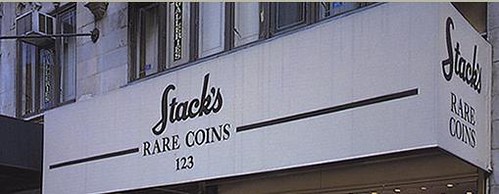
To read the earlier E-Sylum article, see: QUERY: WHO WORKED AT STACK'S IN 1966? (www.coinbooks.org/esylum_v14n11a08.html)
QUERY: WHERE AND WHEN WAS STUART M. MOSHER BORN?
In conjunction with redeveloping the biographical sketches on ANA Numismatic Hall of Fame honorees for resurrecting a meaningful recognition at the headquarters in Colorado Springs, we have been unable to pin down the where and when for the birth of Stuart M. Mosher who served as editor of "The Numismatist" from 1945 to 1954.
Records available at ANA indicate that he was born in 1904 in Nova Scotia and died on February 20, 1956, at Oakton, Virginia.
A data search did not result in a data match for a Stuart M. Mosher being born in Nova Scotia in 1904.
The search did reveal, however, that a Stuart Marshall Mosher was born in Saint John, New Brunswick, on January 10, 1903.
In the Spring, 1998 issue of "The Asylum," the late Randolph Zander referred to Stuart Mosher as having been a "Down East Bluenose," but that reference was not accompanied by any indication of place or date of birth.
Could anyone possibly assist us in pinning down the desired biographical data?
I may be contacted at mish@EclecticPursuitsIola.com
QUERY: THE FIRST STREET COIN DEALER IN NEW YORK?
Tom writes:
In the category of "things never change," consider this excerpt from Scribner's Monthly – An Illustrated Magazine for the People, "The Street-Vendors of New York" by E.E. Sterns, Volume 1, December 1870, p118, which sheds light on an interesting time in American coin collecting when large cents were phased out.
In the year of the Fremont campaign, an intelligent young Irishman tried to sell some old cents which had accidentally come into his possession, but the coin-dealer would not pay what the young man thought they were worth, and he resolved to offer them to the public himself. Accordingly, to the consternation of his friends, he at once established himself as the first street coin-vender in New York, believing that he could at least make enough to buy a loaf of bread every day, and a pound of beefsteak on Sunday.
Fortune favored the young dealer, for the numismatic fever prevailed in 1857, and he surprised every one by clearing fifteen hundred dollars in eighteen months. Considering himself independently rich, he thereupon made a trip to the old country; but on his return he found such an abatement in the rage for coin-collecting, that since then he has only made a modest living as a street-vender of rare, curious, and ancient currency. For many years he stood at the corner of Broadway and Chambers streets, but last summer he migrated and became a Wall street dealer!
He is a man of moderate stature, quiet manner, and pleasant countenance, with short brown beard and moustache, comfortable attire, and a narrow green necktie embroidered with white silk. His coins are fastened in rows with copper tacks upon three small boards, which are covered with white paper, and suspended by loops of twine to the tips of the iron railing near the Treasury Building.
There are American coins on one of these boards, European coins on the second, and small silver Roman coins on the third, besides various medals and tokens in a square red, wooden, cord-suspended box, which also contains a little pile of dingy old paper "Continental money," varying in denomination from three pence to eighty dollars, and most of it made in Pennsylvania, and inscribed with the ominous warning, "To counterfeit is death."
The highest price this vender ever received was paid for a cent of 1799, which brought forty-five dollars on account of its perfectness and rarity. He sold some time ago an album, containing eighteen hundred kinds of postage-stamps, for three hundred and seventy five dollars, and, in fact, drives a brisker trade of late in stamps than in coins. He also has for sale a very unique collection of "war envelopes," embellished with an infinite variety of patriotic designs. But these sell slowly, and "selling coins," he says, "is just like fishing; you never know when you will have a bite. Some days I don't get a dollar, and again I take fifty dollars in a single afternoon."
Tom adds:
Question for the E-Sylum readers: Name that vendor!
To read the complete article, see:
The Street Venders of New York
(books.google.com/books?id=wkbJr6aElDwC&lpg=
PA118&ots=DU7PyjWfwO&dq=the%20first%20street%20coin%20vendor%20in%20New%20York
&pg=PA118#v=onepage&q&f=false)
To read the earlier E-Sylum article, see: WAYNE'S NUMISMATIC DIARY: MARCH 13, 2011 (www.coinbooks.org/esylum_v14n11a18.html)
CAN UNPUBLISHED MANUSCRIPTS BE SAVED?
Pete Smith writes:
In 2008 I calculated that I had more than a thousand pages of unpublished manuscripts. I thought a couple of my projects included information that might be valuable to a few readers but did not have a large enough market to justify publication.
I have talked with several people who said they were writing books on some topic but I have not seen those books appear in print. I wonder what valuable information was gathered but never published. Is there a way to preserve and distribute such documents or will they be lost forever?
NOTES FROM E-SYLUM READERS: MARCH 20, 2011
Still No Word From Numismatic Museum of Athens
Bob Knepper writes:
A little more follow-up on my still-unsuccessful search for pictures of modern Greek pattern coins:
The same issue of The E-Sylum that reported my lack of success had some info about the Bank of Greece. I followed that trail to a lady who writes a blog about life in Athens. She advised me that the Numismatic Museum of Athens is still open but she added "some Greek institutions are terrible about replying to emails". She gave me another email address but it has not responded.
I also tried an email to a coin dealer in Athens but, again, with no response.
Believe I must drop the subject till I encounter someone who is or will be in Athens.
To read the earlier E-Sylum article, see: NOTES FROM E-SYLUM READERS: MARCH 13, 2011 (www.coinbooks.org/esylum_v14n11a14.html)
The Nobel Museum
Regarding the chocolate Nobel medal, Howard Berlin writes:
You mention the Nobel Museum in Stockholm in last week's E-Sylum, Here are two pictures I took when I was at the museum in Stockholm in 2008.
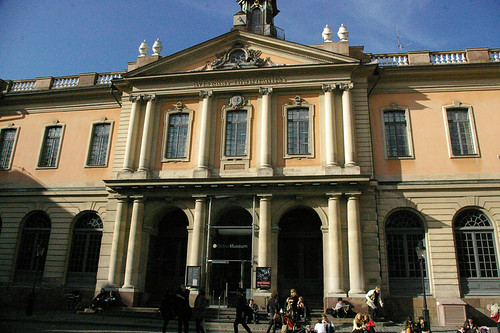
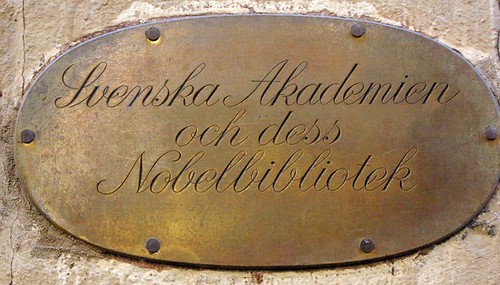
More on Clinton's Vietnam Challenge Coin
Responding to Ken Berger's comment, Howard Daniel writes:
 Ken Berger is right about the man's shirt on President Clinton's Vietnam Visit commemorative medal. The man's shirt is not uniquely Filipino but it is sold all over Southeast Asia, and I own a couple myself. But the hats and the ladies dress are definitely not Vietnamese. I disagree with Ken that the people on the medal could be an acceptable composite of Southeast Asians. When visiting a particular country and commemorating your visit, you pick designs that represent it, and especially when it is a diplomatic event.
Ken Berger is right about the man's shirt on President Clinton's Vietnam Visit commemorative medal. The man's shirt is not uniquely Filipino but it is sold all over Southeast Asia, and I own a couple myself. But the hats and the ladies dress are definitely not Vietnamese. I disagree with Ken that the people on the medal could be an acceptable composite of Southeast Asians. When visiting a particular country and commemorating your visit, you pick designs that represent it, and especially when it is a diplomatic event.
Before I became interested in Southeast Asian numismatics, I was propagandized by a man by the name of John Novak back in 1964. He was a collector and researcher of East Asian numismatics and he was very disappointed that more Americans were not collecting this part of the world. He needed someone to collect Viet Nam and he eventually convinced me I should be that person. At that time outside of East Asia, I was about the sixth person in the rest of the world to specialize in that country. His hope was that Americans who researched and wrote about East Asian numismatics could also teach Americans more about the region, and if they learned more, they would make less mistakes concerning it.
When I started my six years of service in Viet Nam in 1966, I was one of a VERY few who actually knew some of the history and culture of the country. Many operations were planned and executed like they were done in World War II and the Korean War. Most did not work. Other operations were conducted like those by the British in Malaya. They also did not work. Each country and people are unique and react to actions in different ways. T
he Vietnamese people are very proud of their culture, and dress is part of it. Not using the proper conical-shaped hat and clothes on a medal for a visit to their country is a big deal and they probably did not laugh in front of President Clinton and his accompanying officials, but they surely did behind their backs! But they were also likely very disappointed that enough research and thought was not put into the design.
San Francisco Numismatic Connections
Davie Lange writes:
 I'm glad you included the color photograph of San Francisco after the 1906 earthquake, but you were incorrect in stating that the recently discovered photos did not include anything of numismatic interest.
I'm glad you included the color photograph of San Francisco after the 1906 earthquake, but you were incorrect in stating that the recently discovered photos did not include anything of numismatic interest.
The triangular structure shown at the left of the photo is the Flood Building, which still stands today at the corner of Powell and Market Streets. It was named in honor silver baron James C. Flood, whose fortune was based on the Comstock Load silver which went into so many of the Gilded Age coins we now collect. From 1952 until the chain closed in this country, San Francisco's branch of the F. W. Woolworth Company was located on the ground floor and basement of this building.
It was in that store's coin and stamp department that I made some of my first numismatic purchases 40+ years ago. The coin and stamp sales took place in a large, square booth somewhat akin to that of a carnival game. It was located not far from the ubiquitous Woolworth lunch counter, and to this day I still equate the smell of greasy burgers with the childhood thrill of coin buying.
To read the earlier E-Sylum article, see: HERBERT IVES AND THE AMERICAN NUMISMATIC SOCIETY (www.coinbooks.org/esylum_v14n11a15.html)
How Lobbyists Protect the Paper Dollar
On the GAO study mentioned last week, David Lange writes:
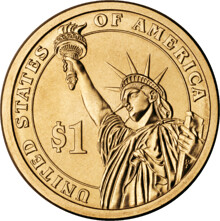 Regarding the latest "discovery" of the dollar coin's superiority to the dollar bill, I suspect that this will just result in yet another expensive government feasibility study the results of which will once again be disregarded by Congress and the Treasury.
Regarding the latest "discovery" of the dollar coin's superiority to the dollar bill, I suspect that this will just result in yet another expensive government feasibility study the results of which will once again be disregarded by Congress and the Treasury.
Lobbying by the supplier of bank note paper and the desire to protect federal jobs will, as always, shoot this idea down. These interests always publish surveys whose questions are slanted to result in positive public support for the paper dollar over a dollar coin.
It's unfortunate that no one in a position to change matters is willing to acknowledge the obsolescence of both the cent and the paper dollar. As Dick Johnson has remarked several times, our coinage system needs a comprehensive overhaul, but even small steps toward improvement seem impossible in the face of vested interests.
To read the earlier E-Sylum article, see: GAO RECOMMENDS REPLACING DOLLAR NOTE WITH COINS (www.coinbooks.org/esylum_v14n11a16.html)
FREE SHIPPING ON YOUR WHITMAN ORDER!
CHRISTOPHER MEMMINGER AND THE CREATION OF CONFEDERATE CURRENCY
On March 9, 1861, the mood in the new capital was jubilant. Celebratory cannon fire rang through the streets. Roving bands of patriots honored Confederate officials with nighttime serenades. The first flag of the Southern nation could be seen flying over the Alabama state Capitol, the site where, one month earlier, Jefferson Davis had been inaugurated president of the Confederacy before a crowd of thousands. "[T]he grandest pageant ever witnessed in the South," reported the New York Times. Now a provisional congress held session in its chamber, doing the far less glamorous work required to bring the Confederacy into being. It was not enough to declare a country; it had to be legislated, down to the most mundane detail.
That day, the congressmen passed a bill that gave the Confederate treasury the power to print notes. The amount they authorized was relatively small: only $1 million. In the coming months, however, that number would increase dramatically. Over time, Confederate paper currency would outgrow its modest origins in Montgomery and become the South's single most important source of revenue — the financial fuel without which the machinery of its government would cease to function. It would both help and hinder the Confederate war effort, sustaining the South in the short term at the cost of future disaster.
The man the legislators entrusted with the authority to make money was sitting among them in the chamber: Christopher Gustavus Memminger, a delegate from South Carolina and President Davis's choice for Treasury secretary. Memminger's white hair, blue-gray eyes and sharply featured face had been a fixture in Montgomery for weeks. The month before, he had chaired the committee that drafted a provisional Confederate Constitution in just four days. His loyalty to the Southern cause was beyond question — yet he differed in one crucial respect from his colleagues. He wasn't a native-born Southerner. In fact, he had been born in Germany, and grew up an orphan in Charleston. A foreigner without a family, he would always remain somewhat of an outsider in the keenly class-conscious aristocracy of the South.
To read the complete article, see: Money for Nothing (opinionator.blogs.nytimes.com/2011/03/14/money-for-nothing/)
PUBLISHER LIMITS SHELF LIFE FOR LIBRARY E-BOOKS
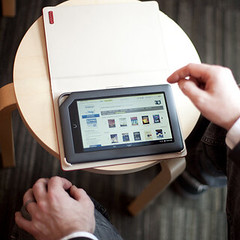 Imagine the perfect library book. Its pages don't tear. Its spine is unbreakable. It can be checked out from home. And it can never get lost.
Imagine the perfect library book. Its pages don't tear. Its spine is unbreakable. It can be checked out from home. And it can never get lost.
The value of this magically convenient library book — otherwise known as an e-book — is the subject of a fresh and furious debate in the publishing world. For years, public libraries building their e-book collections have typically done so with the agreement from publishers that once a library buys an e-book, it can lend it out, one reader at a time, an unlimited number of times.
Last week, that agreement was upended by HarperCollins Publishers when it began enforcing new restrictions on its e-books, requiring that books be checked out only 26 times before they expire. Assuming a two-week checkout period, that is long enough for a book to last at least one year.
What could have been a simple, barely noticed change in policy has galvanized librarians across the country, many of whom called the new rule unfair and vowed to boycott e-books from HarperCollins, the publisher of Doris Lessing, Sarah Palin and Joyce Carol Oates.
"People just felt gobsmacked," said Anne Silvers Lee, the chief of the materials management division of the Free Library of Philadelphia, which has temporarily stopped buying HarperCollins e-books. "We want e-books in our collections, our customers are telling us they want e-books, so I want to be able to get e-books from all the publishers. I also need to do it in a way that is not going to be exorbitantly expensive."
To read the complete article, see: Publisher Limits Shelf Life for Library E-Books (www.nytimes.com/2011/03/15/business/media/15libraries.html)
LIBERTY DOLLAR CREATOR CONVICTED IN FEDERAL COURT
 The leader of a group that marketed a fake currency called Liberty Dollars in the Asheville area and elsewhere has been
found guilty by a federal jury of conspiracy against the government in a case of "domestic terrorism."
The leader of a group that marketed a fake currency called Liberty Dollars in the Asheville area and elsewhere has been
found guilty by a federal jury of conspiracy against the government in a case of "domestic terrorism."
Bernard von NotHaus was convicted Friday at the conclusion of an eight-day trial in U.S. District Court in Statesville. The jury deliberated less than two hours, according to the Department of Justice.
Charges remain pending against William Kevin Innes, an Asheville man who authorities said recruited merchants in Western North Carolina willing to accept the "barter" currency, according to court records. Innes was indicted along with von NotHaus in 2009.
The coins were marked with the dollar sign, the words "dollar," "USA," "Liberty," "Trust in God" (instead of "In God We Trust") and other features associated with legitimate U.S. coins.
The case was investigated by the FBI, Buncombe County Sheriff's Office and U.S. Secret Service with help from the U.S. Mint.
Von NotHaus, 67, faces up to 25 years in prison during sentencing, which hasn't been scheduled. The government also is seeking the forfeiture of about 16,000 pounds of Liberty Dollar coins and precious metals valued at nearly $7 million.
"Attempts to undermine the legitimate currency of this country are simply a unique form of domestic terrorism," U.S. Attorney Anne Tompkins said. "While these forms of anti-government activities do not involve violence, they are every bit as insidious and represent a clear and present danger to the economic stability of this country."
To read the complete article, see:
Liberty Dollar creator convicted in federal court
(www.citizen-times.com/article/20110319/NEWS01/110319006/1001
/news/Liberty-Dollar-fake-currency-creator-convicted-federal-court?odyssey=nav%7Chead)
To read the complete press release, see: Defendant Convicted of Minting His Own Currency (charlotte.fbi.gov/dojpressrel/pressrel11/ce031811.htm)
DICK JOHNSON ON GOVERNMENT SCAM ALERTS
The April issue of Reader's Digest arrived this week. Topping the list of Scam Alerts (page 23) is the $29.95 medal for the 10th anniversary of 9/11 issued by National Collector's Mint.
The magazine reports that "Senator Charles Schumer and Representative Jerrold Nadler of New York have asked the Federal Trade Commission to investigate the National Collector's Mint." Further: "the outfit is charging $29.95 'for a trinket, whose true value has been estimated as low as 2 cents and as high as 60 cents' according to a New York Daily News editorial.'"
One might ask "What business is it of Senator Schumer or Rep Nadler, or even of the New York Daily News or the Reader's Digest what price a private company can charge for its product?"
If that $30 price is a scam for even 60 cents worth of metal, it is a greater scam for Reader's Digest to charge $3.99 per copy where it contains only five cents worth of paper!
These scam-masters did not take into consideration it costs close to $5,000 for artist's models and dies, plus another $1 to $2 each to strike that medal, plus an additional cost to add the partial silver plating. Plus the promotional cost of marketing the medal.
"What business you ask?" If you research WHY legislators Schumer and Nadler instigated their original complaint seven years ago for the first medal National Collector's Mint issued. The answer was they had entered a bill in Congress for the government to issue a 9/11 commemorative medal. They didn't want a private firm in competition with their medal! Take note, Federal Trade Commission.
WASHINGTON POST ARTICLE ON NATIONS OUTSOURCING BANKNOTE PRODUCTION
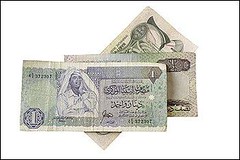 The British government crippled Moammar Gaddafi's attempt to fund his faltering regime this week by
impounding nearly $1.5€ billion worth of Libyan dinars, which had been printed under contract
by a British firm. Wait, how many countries outsource their currency?
The British government crippled Moammar Gaddafi's attempt to fund his faltering regime this week by
impounding nearly $1.5€ billion worth of Libyan dinars, which had been printed under contract
by a British firm. Wait, how many countries outsource their currency?
Half the world. Of all bank notes, 10 to 20 percent are printed by private companies, such as the Britain's De La Rue, Canadian Banknote Co., Giesecke & Devrient in Germany, and Crane, a printer working in Sweden and Massachusetts. Of the world's 171 currency-issuing authorities - there are more countries than currencies, because of the European Union and an economic union of West African countries - about 50 percent outsource some portion of their printing. Giesecke & Devrient, for example, prints currency for five dozen countries, and Canadian Banknote fills orders for 20.
Many governments don't talk about the practice, and the printing houses refuse to release their client lists. Singapore, Finland, Sweden, Bahrain and Qatar are known to outsource their printing. Controversy erupted in India last year when its outsourcing became public. The Philippines has ordered notes from a broad for years, with mixed results. In 2005, the French company Oberthur misspelled the president's name on some bills.
Smaller countries outsource their printing needs for economic and technical reasons. Bank note production is a niche business, and the machines required to make modern currency are expensive and rare. The smallest and cheapest printing systems available can produce a billion notes a year, so if a country needs fewer than that - and many do - they'd be wasting their investment. Some smaller countries choose to keep their printing in-house despite the inefficiency, for national security reasons. (More may do so after Britain's response to Gaddafi.)
To read the complete article, see: Libya is one of many nations that outsource currency production (www.washingtonpost.com/wp-dyn/content/article/2011/03/11/AR2011031107663.html)
BANK OF CANADA SWITCHING TO POLYMER NOTES
 The Australian company chosen to help make this country's new plastic-based currency is embroiled in an international scandal that includes allegations of million-dollar kickbacks and even of offering a prostitute to one client.
The Australian company chosen to help make this country's new plastic-based currency is embroiled in an international scandal that includes allegations of million-dollar kickbacks and even of offering a prostitute to one client.
However, the Bank of Canada said that while it's aware of the allegations against Securency International, they won't delay this November's release of the new Canadian currency.
"The bank is fully aware of the allegations related to past business practices of Securency International," said Bank of Canada spokeswoman Julie Girard in an email to Postmedia News.
Securency International, a company started and partially owned by the Reserve Bank of Australia, that country's central bank, has been tapped to provide the material — a non-porous, plastic film that makes counterfeiting extremely difficult and bills more durable — for the new Canadian currency.
Last week, the Bank of Canada announced it is introducing new $100 bank notes, printed on the special polymer base, starting in November, with new $50 bills to follow next March.
Securency, however, has been the subject of an investigation by the Australian Federal Police and the British Serious Fraud Office into allegations that agents employed by the company paid millions of dollars in kickbacks to government officials in countries such as Malaysia, Vietnam and Nigeria to encourage them to use their product.
To read the complete article, see:
Currency firm picked by Bank of Canada embroiled in bribery scandal
(www.montrealgazette.com/business/Currency+firm+
picked+Bank+Canada+embroiled+bribery+scandal/4444060/story.html)
EARTHQUAKE DAMAGE TO LIBRARIES
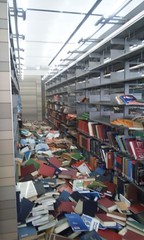 Bibliophiles might be interested to see the damage caused to libraries in last week's earthquake in Japan. A web page has been set up where librarians can share their photos. Have any of our E-Sylum brethren experienced an earthquake? How did it affect your library?
-Editor
Bibliophiles might be interested to see the damage caused to libraries in last week's earthquake in Japan. A web page has been set up where librarians can share their photos. Have any of our E-Sylum brethren experienced an earthquake? How did it affect your library?
-Editor
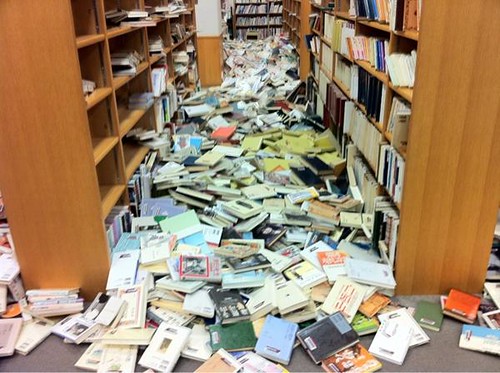
To view the images, see: Earthquake Damage to Libraries (togetter.com/li/110567)
FEATURED WEB SITE: THE CHOPMARK COLLECTORS CLUB
This week's Featured Web Site is the Chopmark Collectors Club.
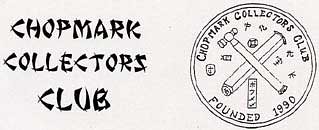
Chopmarks.org is the website of the Chopmark Collectors Club. Established in 1991 the Chopmark Collectors Club is a special group of numismatists who collect coinage with oriental chopmarks.
www.chopmarks.org

